Get to Know the Artists: Michael Elwood, Annelise Kinney, & Daniel Rawlings
The creators of Busy Bead Maze, a large-scale outdoor installation evoking nostalgia for those recognizable fixtures in pediatrician’s offices, are a trio of current Kansas City Art Institute students: Michael Elwood, Annelise Kinney, and Daniel Rawlings. Annelise is beginning her senior year, Michael and Daniel are juniors, they are all working towards their BFA in sculpture.
Their piece has had a little bit of a rough summer; because of the nature of the piece, and it’s placement in West Terrace Park, people have been climbing on the art and subsequently it has suffered multiple breakages. While frustrating, the artists recognize the learning opportunity this presented and have made the necessary changes to their design. The ironic part of the whole situation, according to the artists, is that while the need for repair is frustrating, the whole reason it broke in the first place is that people were playing on it. It’s hard to be upset with the public for enjoying something you made to the point of destruction, even if there were signs asking y’all not to climb on it.
We met at Union Station in the middle of July (because they have really good A/C) to discuss their piece, their future as artists, and what they have learned this summer.
Q: Please describe your project
Annelise: Our project for Art in the Loop is a large-scale installation playscape.
Michael: It’s designed to bring the community together for play.
Daniel: We wanted it to spark the youthfulness in people.
Q: What inspired/influenced you for this particular project?
A: Michael and I both have depression and were thinking about what we needed as individuals. We have found that physical activity, especially doing something playful, has been really helpful for working through things like anxiety and depression. Performing actions, moving items around, it acts almost like a meditation, a healing process for us.
D: The installation evokes the nostalgia for those toys in doctor’s offices, they’re a distraction from whats bothering you. So the toy and our piece both act as distractions, but also, because of the physicality and the repetitive motions, it is a subtle relief from the struggle.
A: Yeah, people always tell us ‘This reminds me of those toys when I was a kid at the doctor.’ It creates an emotional response.
M: This project for Art in the Loop is actually the second installment of the Busy Bead Maze. The first was on the KCAI campus, and we put it there to remind students who were stressing out about finals and their projects to take a minute to play and relax. It went over with the students really well, it had a following, people were emotional about it, and we wanted to bring it to a wider audience.
Q: How does this work tie into the current Art in the Loop theme of “KC Plays!”?
A: It’s an open, inviting game, in a safe space. The KCAI installation was there for students, this one is open to the public in a park, and the hope is that people will come out on their breaks and relax a little before going back to work.
D: It’s a simple way for people to have fun, the act of moving a bead along a pipe, its fun and simple. Also, the texture of the beads is a pleasant surprise.
M: And ya know, the doctor’s office thing; the nostalgia the installation brings to people.
Q: What do you hope people gain from interacting with your project?
D: Again, our original intention with the KCAI installation was to encourage students to take a moment to relax and invite playfulness into their day. With this one in West Terrace Park, because of where it is located, we are hoping to light that fire of childhood in adults who maybe work office jobs, and that playfulness is a break from the mundane.
A: Do you ever feel like you are living in a cloud? Hopefully, our piece in the park can help break people out of their daily clouds by inviting them to play, relax, and be in the present moment.
M: Getting out of that mindset of repetition and mundane routine, and be able to appreciate a more impactful and aware nature.
Q: What kind of feedback have you received from the public in regards to your current Art in the Loop piece?
M: Mostly appreciative, people really seem to love it. Seeing someone play on and with it really sticks to you. At KCAI I once saw a little boy and his mother walking by the campus and the kid literally stopped and ran right to it. That moment of excitement for him and that excitement is transferred to us. Parents think it’s great because its based on thought and creativity.
D: At KCAI it kind of became like a recognized ‘hang-out spot’ for students.
A: When we removed the KCAI installation, a bunch of freshmen were sad it was going away, they had grown attached to it, gotten used to its presence and the mental release it allowed. They even helped us remove it. State Street gets to see this new one [at West Terrace Park] every day. People seem to form this ownership with it because it kind of becomes a symbol of the neighborhood. When we get that kind of response it reaffirms to us that it was worth it to make it, to go through the struggle of repairing it. People like it so much they break it, they really do care about our creation.
Q: What inspires/influences you in your work as an artist, in general?
A: Art therapy is the direction I’m going, making is very therapeutic.
M: Annelise and I both are working towards art as social practice. For me, it’s about finding the moment. The peacefulness, guiding the piece, and the piece guiding you at the same time, losing yourself in your work. That is the moment I live for.
D: I’m inspired by the act of creating, by the wonder of the audience. Before I began working as an artist, I was very much in the routine. Then I found sculpture and everything changed for me, I’ve become invested in creating ways to get people out of that routine.
Q: What has this experience of working with Art in the Loop taught you as an artist?
A: Well, public art is different than gallery shows. When you put things in a white-walled space, that setting can be limiting; working outside, in a public park setting, allows the art to be more accessible. This experience has helped me understand myself more, why I like to make. You don’t know where or what you want to be until you go out of your comfort zone, and while the project was familiar, it was definitely a different experience. Doing this project for Art in the Loop was the hardest thing we’ve worked on. It helped me to explore the medium and define myself while still in this safe zone as a student.
M: The chance to work outside and on a large-scale was really freeing and the unexpected nature of the art and the location was fun.
D: I learned all about the struggle of public art, and trying to control the people and what they do with your piece.
A: When we got the picture of it being broken, and it was instant dread. But we thought, no, this means people have loved it, like really really loved it, so intensely it broke. And fixing it is useful, teaching us lessons about what to do differently next time.
M: It has been really rewarding for us. I think we all learned that there are some things we will do differently next time. We had a difficult location for our piece, but it’s shown me a lot of what public art is, and the difficulties that come with it. I’d love to continue working with public art and continue putting myself out there, making mistakes, figuring it all out. This was a huge learning experience.
A: This was the largest, most intense, professional experience I’ve had.
M & D: Yeah, for sure.
Q: What is your next move?
M: As a group, we are moving the original Busy Bead Maze from the KCAI campus to Cornerstones of Care, which is going to keep the work alive.
A: Cornerstones of Care is a facility in Midtown that helps kids with rough home lives. They house them, feed them, educate, help them deal with the trauma they’ve had. We reached out to them about installing the original piece into their new sculpture garden.
D: Other than the Cornerstone stuff, we are getting ready for school to start and getting back to our individual work.
M: I’d like to experiment more with 3D modeling and rendering, see what I can make.
D: In my individual practice, I miss the musical aspect of my creativity, so I’d like to incorporate that back into my visual work.
A: While I really enjoy working with people and the opportunity to think outside the box, I’d like to do a solo show of my more personal work. It’s ceramic creature…vessels…its hard to explain right now, but it is intended for display in a public space. It’s very different work from what we did with Art in the Loop.
Q: Who is your favorite artist?
A: Louise Bourgeois. She digs in deep within herself in her work. Her practice is therapeutic and she’s a teacher; she talked about space in a way, with a sensitivity that I identify with.
M: Louise Bourgeois. I love her as well! In her work, you can see the progress she has in her work, as a person. Her life experience is directly related to her work, it is raw and honest. I really enjoy her Insomnia Drawings, you can feel emotions through it that are difficult to process. She revisits old subjects a lot, works through stuff, it’s beautiful.
D: Louise Bour….haha just kidding. Frank Gehry. His architecture is akin to artwork, they’re more artistic spaces than buildings. He challenged what architecture was, and turned it into what he wanted it to be.
You can see Busy Bead Maze in West Terrace Park, at 8th & Pennsylvania, now through September. Please remember not to climb on the sculpture. For more information about the artists and Art in the Loop, click here.
Please do not climb on the sculpture

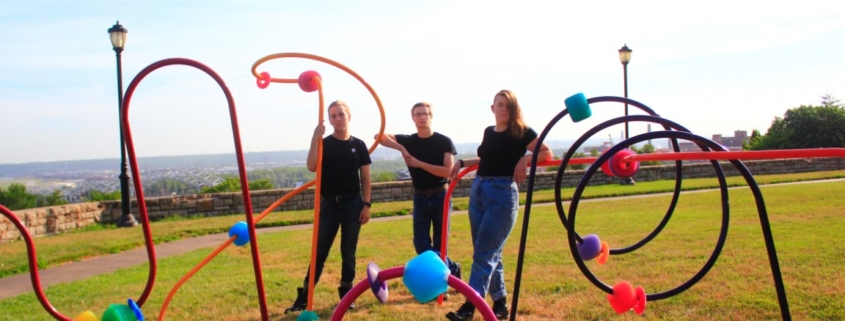
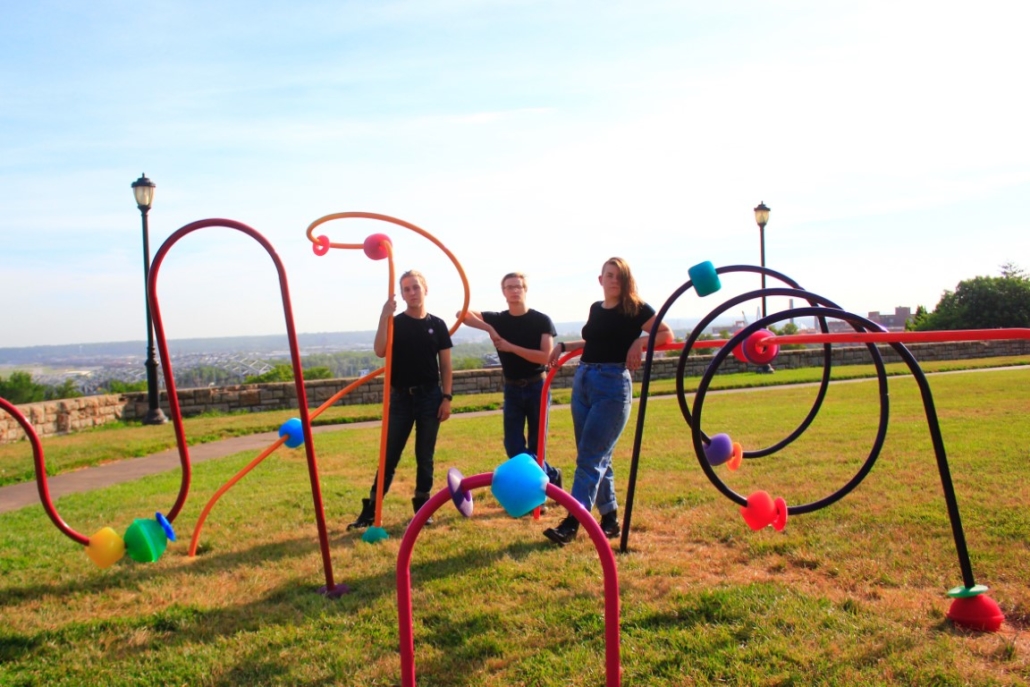
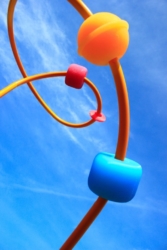
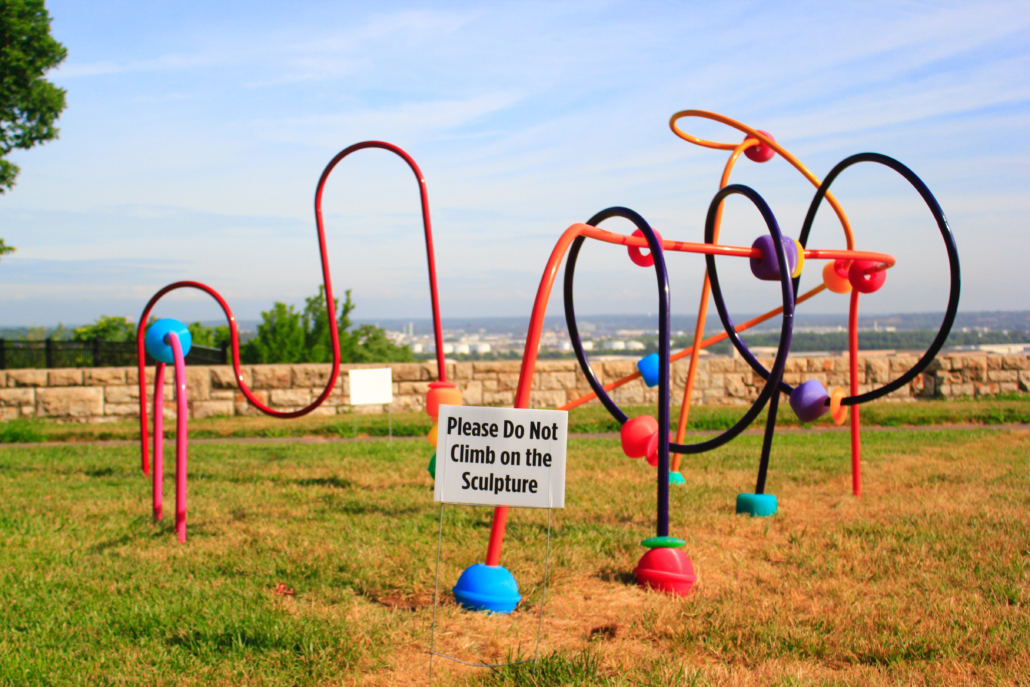
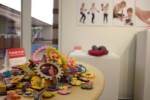
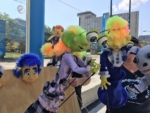
Leave a Reply
Want to join the discussion?Feel free to contribute!